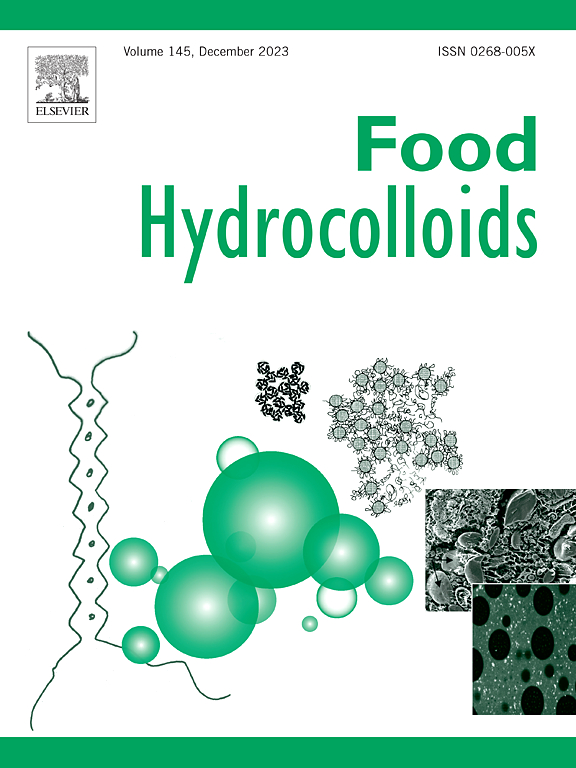酶交联大豆蛋白气凝胶:预冻过程的结构和功能调节
IF 11
1区 农林科学
Q1 CHEMISTRY, APPLIED
引用次数: 0
摘要
生物聚合物气凝胶,特别是蛋白质基气凝胶,因其环保、高孔隙度和独特的功能特性而受到广泛关注。然而,使用大豆分离蛋白(SPI)作为唯一的前体材料生产气凝胶仍然具有挑战性,特别是在实现所需的结构和功能特性方面。本文研究了不同的预冻温度(- 20℃(A20)、- 80℃(A80)和- 196℃(A196))对单组分SPI气凝胶结构和功能性能的影响。以转谷氨酰胺酶(TGase)交联SPI水凝胶为前体制备单组分SPI气凝胶,并在不同温度下进行预冻。在3种气凝胶中,A80气凝胶的结构完整性最高,具有连通的枝状孔隙结构,孔径分布最广,孔隙率最高,为92.67±0.53%。A196的微观结构最致密,孔径分布最集中,孔隙率最低,为90.43±0.28%。重要的是,预冷冻处理显著影响SPI气凝胶的结构特性。与A20和A80气凝胶的有序结构相比,A196气凝胶的有序结构较少,β-匝和随机线圈的存在较多。A196气凝胶的吸油能力(OAC)和持油能力(OHC)最好,A80气凝胶对染料的吸附能力最好。这些发现为单组分tgase交联SPI气凝胶的制备提供了新的见解。本文章由计算机程序翻译,如有差异,请以英文原文为准。

Enzyme-crosslinked soy protein aerogels: Structural and functional modulations by pre-freezing process
Biopolymer aerogels, particularly protein-based aerogels, have garnered significant attention due to their environmentally friendly nature, high porosity, and unique functional properties. However, the production of soy protein isolate (SPI) aerogels using SPI as the sole precursor material is still challenging, particularly in achieving the desired structural and functional properties. Herein, the effect of different pre-freezing temperature (−20 °C (A20), −80 °C (A80), and −196 °C (A196)) on structural and functional properties of single-component SPI aerogels is investigated. The single-component SPI aerogels are prepared by transglutaminase (TGase)-crosslinked SPI hydrogels as precursors and then pre-frozen at different temperatures. Among three aerogels, A80 aerogel exhibits the highest structural integrity, featuring an interconnected, dendritic pore structure, which results in the most extensive pore size distribution and the highest porosity of 92.67 ± 0.53 %. In contrast, A196 demonstrates the most compact microstructure and the most concentrated pore size distribution, with the lowest porosity of 90.43 ± 0.28 %. Importantly, the pre-freezing treatment significantly influences the structural properties of SPI aerogels. A196 aerogel shows less ordered structures, with a higher presence of β-turns and random coils, compared to the more ordered structures observed in A20 and A80 aerogels. Moreover, A196 aerogel exhibits the best oil adsorption capacity (OAC) and oil holding capacity (OHC), while A80 aerogel demonstrates the highest dye adsorption. These findings provide new insights into the fabrication of single-component TGase-crosslinked SPI aerogels.
求助全文
通过发布文献求助,成功后即可免费获取论文全文。
去求助
来源期刊

Food Hydrocolloids
工程技术-食品科技
CiteScore
19.90
自引率
14.00%
发文量
871
审稿时长
37 days
期刊介绍:
Food Hydrocolloids publishes original and innovative research focused on the characterization, functional properties, and applications of hydrocolloid materials used in food products. These hydrocolloids, defined as polysaccharides and proteins of commercial importance, are added to control aspects such as texture, stability, rheology, and sensory properties. The research's primary emphasis should be on the hydrocolloids themselves, with thorough descriptions of their source, nature, and physicochemical characteristics. Manuscripts are expected to clearly outline specific aims and objectives, include a fundamental discussion of research findings at the molecular level, and address the significance of the results. Studies on hydrocolloids in complex formulations should concentrate on their overall properties and mechanisms of action, while simple formulation development studies may not be considered for publication.
The main areas of interest are:
-Chemical and physicochemical characterisation
Thermal properties including glass transitions and conformational changes-
Rheological properties including viscosity, viscoelastic properties and gelation behaviour-
The influence on organoleptic properties-
Interfacial properties including stabilisation of dispersions, emulsions and foams-
Film forming properties with application to edible films and active packaging-
Encapsulation and controlled release of active compounds-
The influence on health including their role as dietary fibre-
Manipulation of hydrocolloid structure and functionality through chemical, biochemical and physical processes-
New hydrocolloids and hydrocolloid sources of commercial potential.
The Journal also publishes Review articles that provide an overview of the latest developments in topics of specific interest to researchers in this field of activity.
 求助内容:
求助内容: 应助结果提醒方式:
应助结果提醒方式:


